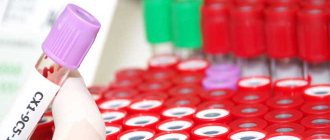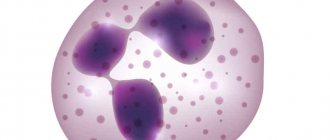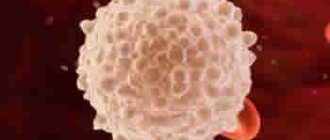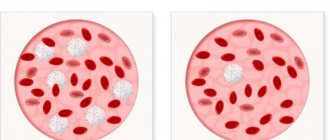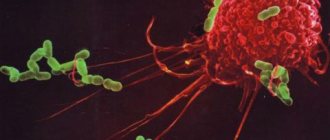Functions of lymphocyte agranulocytes in the human body
Leukocytes refer to white blood cells. They are divided into:
- basophils;
- eosinophils;
- neutrophils;
- lymphocytes;
- monocytes.
The main function of all these cells is to protect the body. That is, the absorption of bacteria, viruses, allergens, mutating (cancer) cells.
Lymphocyte
Lymphocytes, together with other protective blood cells, provide the body with immunity, but unlike the others, they have immunological memory. What does it mean? When re-infected with certain infectious diseases (rubella, chicken pox, measles), lymphocytes work in an accelerated mode, which prevents the development of the pathological process. This type of leukocyte also fights pathological cells of its own body. They prevent the development of cancer.
Symptoms of lymphocytosis
Often, at the initial stage of development of lymphocytosis, the pathology occurs without clinical manifestations. Patient complaints mainly concern the presence of infection, that is, the provoking factor. As the situation worsens, the symptoms become more pronounced.
Signs of increased white cell levels in the blood:
- pathologies of the upper respiratory tract;
- enlarged lymph nodes, liver, spleen;
- hyperemia of the oral mucosa, irritation of the nasal mucosa;
- physical weakness;
- intestinal dysfunction (diarrhea, constipation), nausea;
- a sharp increase/decrease in body temperature accompanied by exhaustion and chills;
- severe enlargement of the tonsils against the background of increased body temperature up to 40 degrees;
- destabilization of the nervous system, fatigue, sleep disturbance;
- Children experience paroxysmal vomiting.
Normal values for women
The normal number of lymphocytes depends on the person's age. The concentration of these cells can be calculated in two ways:
- calculate the approximate content in 1 liter of blood (the norm for women is from 1 to 4.5 billion);
- derive the percentage of the total leukocyte content (the norm for women is approximately 40%).
Lymphocyte levels can fluctuate throughout life for various reasons. These include not only pathological processes, but also physiological changes in the body.
Why lymphocytes in a woman’s blood are elevated should be determined by a doctor. Normal leukocyte counts.
How to get it back to normal
You can lower the indicators after identifying and eliminating the causes of the increase in lymphocytes.
If the deviation from the norm is not associated with a disease, then to restore the balance of the cells it is enough to drink more liquid and eat foods rich in amino acids and microelements, especially zinc and vitamin C.
Emotional and physical stress leads to imbalance of the immune system. Poor nutrition, bad habits, and stressful situations adversely affect the body's protective functions.
In case of acquired lymphopenia, etiotropic therapy is carried out for the underlying disease, which is the root cause of its development.
In cases where the number of lymphocytes exceeded the norm by 15% or fell to an unacceptable 15%, you should:
- maintain hygiene;
- do not visit crowded places;
- do not contact sick people;
- do not touch animals;
- avoid cuts and scratches on the skin;
- consult a doctor.
Medications
The use of drugs to normalize the functioning of protective cells is called immunotherapy.
There are several groups of similar agents with different effects:
- Thymic immunomodulators – thymalin, thymostimulin, thymogen. These drugs are designed to increase the number and activation of T lymphocytes.
- Bone marrow immunomodulators – myelopid and seramil. The object of their influence is B-lymphocytes. They increase general and cellular immunity.
- Cytokines are a combined group of interferons and interleukins. These include viferon, roferon-A, altevir, pegasis, betaeron, imukin, betaleukin, which are a colony-stimulating factor for the body.
- Immunostimulants - bronchomunal, ribomunil - specifically work with cells engaged in phagocytosis. The result of their action is an increase in the number of lymphocytes and their activation.
- Synthetic immunomodulators are nucleic acids that stimulate the formation of phagocytes.
These medications normalize the number of lymphocytes and enhance their activity, help remove circulating immune complexes from the body, thereby unloading the work of lymphocytes, increasing their protective activity.
Traditional methods
It is worth resorting to traditional methods of normalizing the content of lymphocytes in the blood only if the cause has been established and the disease that caused it is known.
If detected lymphocytosis is caused by a viral infection, use:
- Infusion of linden flowers:
- pour 1/2 liter of boiling water 3 tbsp. dried linden flowers;
- leave for 0.5 hours;
- take 100 ml during the day.
In 2 weeks the disease will pass, the lymphocyte count will return to normal.
- Propolis tincture:
- 300g. propolis is infused for a month in 700 g of alcohol;
- take 2 tbsp. 3 times a day for a month.
- Barley decoction:
- Boil 1.5 cups of barley in 2 cups of water until the liquid is reduced by half;
- You should drink half a glass of the decoction in the morning on an empty stomach for a month.
To stop the growth of lymphocytes, use beet infusion:
- cut the root vegetable into cubes and pour in 1.5 liters of hot water;
- add 1 tsp. salt and honey;
- drink a glass 3 times a day for 2 weeks.
Will help white blood cells recover to normal: an active lifestyle, running in the morning, visiting a fitness club, avoiding overwork and stress. Introduce steamed buckwheat and chicory drink into your diet.
Other methods
The most dangerous thing for human health and life remains the loss of the body’s protective functions as a result of AIDS and the development of malignant neoplasms.
A general decrease in all types of leukocytes leads to immunosuppression, decreased immunity and an increased risk of damage by viruses, fungi, bacteria and other dangerous microflora, also after chemotherapy.
Doctors recommend choosing special foods that increase the level of leukocytes in the blood. This method has been confirmed and clinically tested and provides a positive immunostimulating effect.
The diet should contain foods containing:
- Tocopherol (vitamin E) – found in the seeds of oilseeds. Stimulates the activity of NK cells, which are cytotoxic to malignant neoplasms and cells affected by pathogenic microflora. Induces the production of B lymphocytes, which are responsible for the generation of antibodies.
- Zinc – ensures an increase in the number of T-killers and activates B-lymphocytes. The main source is beef, poultry eggs and seafood.
- Selenium – has an immunostimulating effect. Contained in legumes.
- Green tea antioxidants stimulate lymphocytopoiesis.
- Ascorbic acid (vitamin C ) - affects the formation of leukocytes and the generation of interferons. There is a lot of it in black currants and citrus fruits.
- Beta-carotene – stimulates the reproduction of T-lymphocytes. Prevents free radical saturation of lipids. The source of beta-carotene is carrots.
- Retinol (vitamin A) – providing
How to take the test correctly?
The blood picture is well shown by a general analysis. That is why it is prescribed so often. The research is very informative and does not require much time. In order for the indicators in the analysis to be adequate, you need to adhere to some rules. Here's what they're talking about:
- You need to donate blood on an empty stomach.
- The day before the test you should not drink alcohol.
- Smoking is contraindicated for at least 2 hours before the test, otherwise the results will be unreliable.
- Physical activity is also undesirable before collecting biological material.
An increased level of lymphocytes will alert the doctor. This can indicate both minor changes in the patient’s body that can be quickly corrected, and serious diseases that require immediate medical intervention. The doctor will identify the true cause of the excess lymphocytes.
What else do blood test results tell you?
When the form with the results falls into our hands, we want to understand all these unfamiliar concepts and find out what is going on in the body even before visiting the doctor. Therefore, we will try to explain what this or that combination of blood elements means.
In a situation where lymphocytes are increased and neutrophils are decreased, we may be talking about the presence of a viral infection; this is also observed due to the side effects of certain medications. A decrease in neutrophils and an increase in lymphocytes at the same time, as a rule, means that a person has a focus of viral damage. You can find out what neutrophils are here.
Neutrophils are reduced and lymphocytes are reduced, with a normal level of eosinophils, which happens when a person gets the influenza virus.
Increased lymphocytes and decreased neutrophils in the blood most often indicate the development of an inflammatory process, which the human immune system is trying to fight on its own. If the content of lymphocytes is too high, tuberculosis or a malfunction of the thyroid gland can be suspected.
If, according to tests, leukocytes are low and lymphocytes are high, the reasons may be hidden in a current viral infection, for example, whooping cough, chickenpox, measles, viral hepatitis, etc., but this combination can occur in a number of other diseases.
If you detect any abnormalities in your blood parameters, you should not panic and invent false diagnoses. The best decision would be to contact a specialist who will explain the current situation and, if necessary, prescribe additional examination or treatment.
Good health!
What does a high level in women mean and what does it mean?
An increase in lymphocytes can have various causes. This happens when:
- some viral diseases (rubella, chicken pox);
- bacterial infectious processes (tuberculosis);
- lymphadenitis;
- lymphogranulomatosis;
- lymphoma and lymphocytic leukemia.
If lymphocytes in the blood of women are elevated, this means the possible presence of a pathological process. Lymphocytosis itself is not an independent disorder. He is a consequence of the problem.
What are atypical lymphocytes and what do they look like:
As is known, when irritated by antigens, as well as during certain diseases (viral diseases, allergies), lymphocyte counts increase. Along with this, some of them change their properties and appearance.
Atypical lymphocytes acquire the following features
They get big. Typically, macrophages are the largest leukocytes, and lymphocytes rarely “grow” to more than 12 microns. When they become atypical, their size can be 30 microns or more.
A normal lymphocyte has a shape close to round. Changed cell shapes acquire an irregular, polygonal shape, and their borders may look “ragged.”
The nucleus of an ordinary cell is round or slightly elongated. In an atypical lymphocyte it may remain this way, but it is often elongated, with “eaten away” contours, constrictions or clefts. It happens to be reduced.
If a blood smear, in which lymphocyte indicators are studied, is stained with standard dyes (hematoxylin and eosin are used for this), then the atypical cells will acquire a brighter color than the “normal” ones. Their nucleus is purple, and the cytoplasm is gray, dark blue or light blue. If atypical lymphocytes appear in a patient infected with cytomegalovirus or Epstein-Barr virus, they are called Downey cells. The fact is that in 1923, an American hematologist with the same name was one of the first to see them under a microscope and describe their properties. Some lymphocytes with atypical properties are also called Reader cells, or amitotic lymphocytes. Their peculiarity is that they have a kidney-shaped shape and nuclei with jagged contours or a constriction in the middle, dividing them into lobules. Also among atypical lymphocytes, Botkin-Klein-Gumprecht cells are distinguished. Three scientists at once described specific cells that occur in lymphadenosis. Actually, these are not living cells, but their remains, which circulate in the blood for some time. Because they are barely visible, these lymphocytes are also called shadow cells.
What to do?
We discussed above what an increase in lymphocytes means. Now all that remains is to figure out what to do next. An increased number of the cells in question does not always cause panic in a woman. The most important thing in this case is to consult a competent doctor (generalist, hematologist) and find out the cause.
After collecting an anamnesis, the doctor will prescribe additional diagnostic methods, since a general blood test, although an informative method, cannot clearly indicate the localization of the pathological process. There are many reasons for an increase in the number of lymphocytes in women.
Reasons for high and low rates
Any deviations from the norm in lymphocyte counts may indicate pathological processes in the body.
Both high and low lymphocyte counts should be a concern. A high level of lymphocytes is observed in women whose bodies are affected by any viral infection.
In the case of bacterial infection, the number of lymphocytes increases only in tuberculosis and syphilis.
Very often, a high level of lymphocytes is observed when the infection reaches its peak of development.
The doctor should monitor such changes by ordering tests every few days until the patient recovers.
In the event that a woman did not suffer some specific infections in childhood, then when faced with them, her body increases the number of lymphocytes to a significant extent.
Such diseases include rubella, measles, chickenpox, mumps, etc. This increase in the percentage of lymphocytes is associated with the formation of new immune processes.
An increase in the level of lymphocytes is observed when exposed to harmful environmental factors, poisoning with potent chemicals, as well as in case of poisoning by toxins.
In some situations, the growth of lymphocytes causes pathological changes in the body's own cells.
If you suspect a cytological disease, women need to undergo a thorough examination.
A low level of lymphocytes may be associated with a particularly severe infection in the body. Due to the large amount of foreign agent, the lysis of diseased cells occurs too actively, and a significant part of the lymphocytes die.
Video:
At this point, the natural cell replenishment system has not yet had time to restore their normal level. Very often, such indicators appear in the initial stages of diseases.
The level of all protective cells decreases significantly with the development of AIDS, because diseases of this group suppress the immune system. In addition, chronically low lymphocytes are characteristic of patients with tuberculosis.
A decrease in this type of cells is caused by taking certain hormonal drugs and a lack of B vitamins in the body.
If the cause of low lymphocytes is not determined, then the doctor should order a comprehensive study of blood cells to rule out pathologies in this area.
Reasons for the increase in children
Enlarged lymphocytes in a blood test in children, as well as in women, is an alarming symptom of some disease or disorder in the body. Infectious and inflammatory diseases, allergic reactions, malignant neoplasms - all this can cause an imbalance of lymphocyte cells. As with an increased rate in women, a child with lymphocytosis needs to undergo competent diagnostics to identify the underlying disease. Norm of leukocytes in children.
Preparing and conducting analysis
For an objective assessment of a blood test, it is important to follow the established rules on the eve of the test:
- dinner should be light;
- do not drink alcohol;
- exclude smoking;
- do not take strong medications;
- avoid stressful situations;
- a full 8-hour sleep is required;
- Postpone breakfast on the day of blood donation.
There are two ways to obtain biomaterial (blood) for analysis. The first involves drawing blood from a finger by pricking the ring, middle or index finger with a disposable needle. The little finger and thumb are not pierced; this is prohibited due to the risk of infection through punctures in these places.
Treatment with drugs
Depending on the cause of lymphocytosis, the patient should be prescribed drug treatment; the following options exist:
- When an infectious pathogen is identified, antiviral and antibacterial drugs are used: Flemoklav, Amoxiclav, Ingaverin, Grippferon, Interferon.
- In case of poisoning and intestinal infection: Bifidumbacterin, Enterofuril, Enterol.
- Allergic reactions: Citrine, Zodak, nasal sprays with antihistamine effect.
- If cancer is detected, chemotherapy, leukapheresis, and bone marrow transplantation are used.
- If the reason lies in the presence of autoimmune diseases: Hydrocortisone, Traimcinolone, Dexamethasone.
- Treatment of thyrotoxicosis occurs with the help of radioactive iodine, the drugs Tyrosol, Endorm; Complete or partial removal of the thyroid gland is often practiced.
Additionally, vitamin and mineral complexes, painkillers and antipyretics can be used.
What test helps determine the level of lymphocytes in the blood
In order to determine the quantitative content of lymphocytes, a general biochemical blood test is performed. Before donating the material, you should prepare the body and exclude all sorts of activities that could change the composition of the blood. This applies to physical activity, drinks and food consumed, and emotional state.
On the eve of visiting the laboratory for blood collection, you should get a good night's sleep and skip breakfast. The analysis is taken from the fingertips, after which it is deciphered and the result is reported to the patient.
